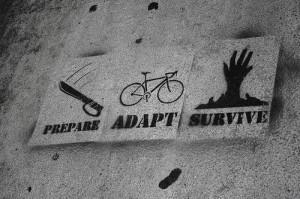 Marketers everywhere are struggling to get their arms around the beast that is content marketing. How to do it in general, how to do it well, and how to get it done on time without going crazy (and often with few resources) are questions that are on a lot of marketers’ minds. That’s precisely why thinking about your content planning with an agile approach might just save your sanity.
Marketers everywhere are struggling to get their arms around the beast that is content marketing. How to do it in general, how to do it well, and how to get it done on time without going crazy (and often with few resources) are questions that are on a lot of marketers’ minds. That’s precisely why thinking about your content planning with an agile approach might just save your sanity.
I love agile and when I saw that Jeff Julian was speaking on agile and content planning at an upcoming Kansas City Direct Marketing Association event, it was on my don’t miss list. Jeff’s presentation was awesome and I’m going to recap some of what he shared. First, though, I’ll share a bit about Jeff.
The Jeff Julian Backstory. He’s a geek and a software developer. Even better, he’s an engaging guy with a software developer’s brain coupled with the ability to dumb it down so that the rest of us can figure out what he’s talking about. He led with the fact that he’s got his kids on an agile program and his wife is the scrum master – from that point on, I was hooked. If you know agile, you’re smiling about now.
Julian started writing software at 14, ditched high school because it was boring, went to college at 17, it was boring, finished up there when he was 20 and ultimately founded Geekswithblogs.net, one of the largest blogging communities on the Web. In its heyday, the site had some 2 million visitors a month and Julian had 4,000 bloggers producing somewhere in the neighborhood of 80,000 posts for the site. Think you’ve got a content planning or management problem? Think about what that must’ve entailed.
Julian sold geekswithblogs.com a couple of years ago. Today, he’s the managing partner of AJi Software, a software development company located in Kansas City, Mo., a best-selling author of a book on content management system development, a Microsoft Most Valuable Professional in XML and SharePoint and, well, the accolades go on. Suffice it to say he knows what he’s talking about. How we both live in the same city and don’t yet know one another is tragic. Tragic, but fixable.
How to Use Agile in Your Content Planning
Julian’s presentation was centered on agile and how to use the agile process to drive your content planning. He covered things like how to estimate the size of content needed, what information to gather and when, and how to plan, review and complete content elements. I’m warning you now, this is a long post, but if you make it through, you’ll be ready to get started with agile in your content efforts. Let’s dive in.
Why Content Marketing? Content marketing is so simple it’s ridiculous. But so many marketers get this wrong. Content marketing isn’t another way for you to spew company propaganda, save that for those glossy brochures. Relationships that you develop with your company’s customers and prospects start with information. Your goal with the content you and your team are developing should have just one goal: helping your audience be more informed and make better purchasing decisions based on the information you share. Content marketing is about developing content that provides value to people. [Notice that doesn’t say anything about cramming marketing messages down people’s throats?]
The Challenges? Content marketing planning is difficult and marketing teams need better planning strategies. Schedules and planning and endless interruptions and demands from within the organization and timelines and not enough budget or resources and deadlines and crazy people. That’s what marketers are dealing with. And everybody needs something yesterday. That’s where agile and software developers who understand and use agile can help make marketers’ lives easier.
Lean/Agile What’s the Difference?
Lean is a technique, it’s a process designed to eliminate waste (time, effort, materials, etc.). Lean is about amplified learning, empowering teams to make decisions, and the like.
Now, that we’ve got lean covered, what is agile? Agile has similar meanings but agile puts the highest priority on customer satisfaction and allowing change to happen quickly. Frequent deliveries, getting things out the door quickly, and at a sustainable pace is an important part of agile. And this is why agile is so important as part of your content planning and development processes – it’s the perfect solution to not only holding onto your own sanity, but to keeping your team happy and satisfied, as well. Measuring and evaluating on an ongoing basis is very important whenever you bring on agile techniques, because you want to make sure that people on your team are not only growing as individuals, but that they also aren’t being overworked and they’re getting value out of it. Agile is also about looking back and evaluating the process–that it’s simple and that it works. And a final key component of using agile is to know that you have to keep rethinking and reevaluating your processes on a regular basis.
The History of Lean and Agile
In case you’re not 100% sure, here’s a brief overview from Jeff’s presentation on the history of lean and agile, and the differences.
1980s
Toyota developed the lean manufacturing model in the 1980s, which was a deviation from the assembly line concept that had been in place for a long time. This was a huge change in the manufacturing industry as a whole and for the automobile industry in particular. The focus of lean was on only producing things that are needed, when they are needed.
1990s and 00s
In the 1990s and 2000s, developers started focusing on agile and embracing scrum. A brief explanation is that that process required developers to estimate what’s needed in order to get a job done, break down the components and the time needed to complete the work, put it into time box, then go away and get the work done without the outside pressure of the organization coming into play. The agile process enables more productivity and reduces stress–both good things.
Today
Agile and lean are everywhere. They both play a key role in streamlining operations and the agile process helps enable greater productivity, creates happier teams and helps you get things done on schedule. Which is exactly why we’re talking about agile as it relates to content marketing.
The Core Work Ahead of Your Agile Team
Here’s where you get started with agile in your content planning and development efforts:
Personas. Developing personas allows you to isolate your target customers, who often look a lot alike. Putting them into groups and naming them, listing out their demographic information and goals helps you isolate them. These personas bridge all departments within an organization (sales, marketing, customer service, product development) and it’s important to remember that. If we only focus on sales prospect personas or only focus on personas for marketing teams, then we leave a lot of potential consumers of our content out of the equation.
Content Backlog. Once you’ve done the work on your target customer personas across the organization, you need to deal with your content backlog. As an agile team, you need to pull information out of that massive content backlog that exists in pretty much every organization, and make something out of it. You also need to put someone in place who has ownership over this process.
Develop Your Content Items. Developing your content items makes what can be an overwhelming process do-able. In this step, you look at each item of your content and create a statement that allows you to develop a target, a value statement, a call to action and a priority determination. This will help you determine what is important to produce when. Here’s a nifty visual from Jeff’s preso to show you what I’m talking about:
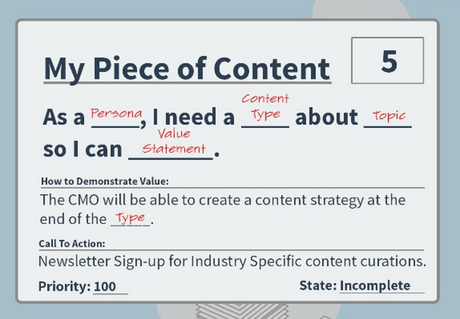
It’s important to remember, though, when it comes to your own operations, that just because you go through the process described above, doesn’t mean (yet) that you know how to demonstrate value. The above is a descriptive statement that will allow you to create a pile of stuff that then allows you to create priorities. Priority is key and is something the aforementioned owner will control. Priority is also extremely important – as you have to be producing the right stuff at the right time, not just running around like chickens with heads cut off trying to get to everybody’s “need it right now” content development requests.
The Art of Estimating
Before you know what you can do, you have to figure out what you’ve got to tackle and what you think it’s going to take. This is called estimating and it’s where you and your agile team look at all the content you’re trying to get your arms around and get in development. You estimate how much time it’s going to take, how important it is on a scale of 1 to whatever it is and what the availability of your group is and then you make a plan. For purposes of this presentation, Jeff referred to the Mountain Goat Software system of Planning Poker™ Scrum cards. The short version of this process is that everybody sits around a pile and everyone who is involved in a project gets one of these cards. If you’re writing a blog about a particular topic, everyone who is available (and qualified) to write about it fills out the card. The infinity card means, “this is way too big, let’s not talk about this now, it needs to be broken down into smaller parts,” and the question mark card means “we need more info before we can do this, so let’s save that for later.”
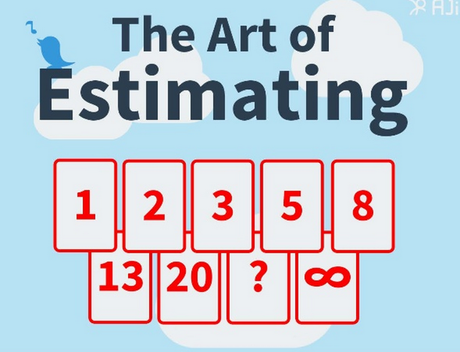
As a result of the estimation process, you and your team will have identified the top priority items and how much time they are going to require, as well as how much time your team has available. You’re almost ready to get started, you just have to determine priorities of the different pieces of content you need to develop and you’ll be ready to get started on production. Not developing priorities is a bit like starting out on a road trip without a destination in mind and/or a map to get you there.

15 day planning – Sprint
Now that you’ve got your priorities determined, you’re ready for the planning stage, which in agile is called the Sprint. You go back to the estimates you’ve developed (based on the above), and the priorities you’ve determined. You look at the availability of your team and how much time you’ve determined each of your assignments will require, and you start divvying things up. See the below slide for an example of what that might look like for content development for a certain project.
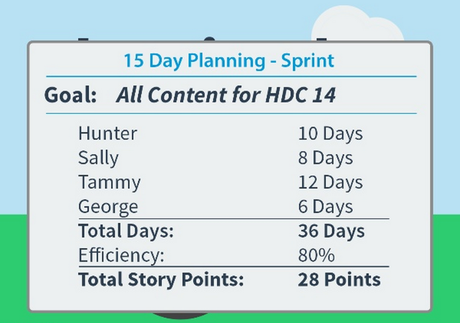
The last part of this equation is that you can each grab a handful of cards and go into your own world and produce the content you need to produce.
If you decide to try implementing agile into your content planning and development, you need to understand that this goes beyond your own department. In order for it to work, you’re going to need the outside world (as in the rest of your organization) to respect this process and respect the priorities of the time you’ve set aside to make this happen (officially called “The Timebox” in agile). You need to make sure each those interruptors (my pet term for them–you know who they are) know that you and your content development team need enough time to get stuff done and that they need to trust that you’ll deliver and then leave you the heck alone. The good news is that once it starts working, you’ll be on the road to having them trained to leave you alone if they want their content!
The Stand Up
Another awesome part of agile is the accountability part of the process. This is called The Stand Up and it happens daily. This is where you gather and look at the Scrum Board with your team as a whole and talk through where you are in the processes. You look at what’s open, what’s in process, what’s complete and what’s not. You look at any problems or obstacles and the leader’s (also called the “Scrum Master”) job is to remove or resolve them. You’re not hiding behind email or text messages or anything else, you’re standing up in front of one another and talking about what you’ve delivered and taking responsibility, in front of your whole team, for what you’ve not yet delivered on. According to Jeff, the physical moving of that Scrum card, which is also the gamification of the process, is the reward. It’s like how good you feel when you can cross something off your to-do list and mark it as done. Those are the moments that your team will come to enjoy the most.
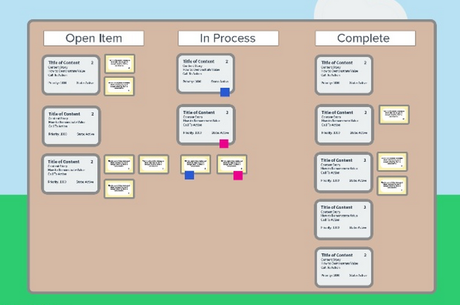
There’s obviously also a reward factor and the shame factor when you haven’t delivered. You can see how as a team you’re progressing within the Time Box and what makes this process work is that you don’t care about the backlog—all that other content that’s out there waiting for you to tackle it. You only care about the right now– the sustainable space you set up as a team and are living within. And within that space, you very clearly know how much is left to do, what additional information you need, and whether or not you’re hitting your targets.
The Retrospective
The last stage of the agile process is the Retrospective. After you’re done, the team is probably ready to complain. So you let them. Of course you try and make this process productive and make sure that your team doesn’t use this exercise to complain about other people, curse one another out and that kind of thing. Your goal here as a team is to discuss the process of that particular Sprint, just that one piece of your content planning and development process, and pick it apart. This is where you come up with things that would make it better, and adapt. This is agile.
So Now You’re a Scrum Master
You didn’t know it when you were reading this post, but what you’ve just gone through after reading the above is the basics of “Scrum Master” training. As a Scrum Master, your job is simple. It’s all about empowering your team and removing impediments and it’s a lot like playing cards–or anything–with kids. When someone starts walking away, you guide them back in and get them moving again. Your job is all about keeping the team functioning well. If you’re a parent, you’re perfectly suited for a job as a Scrum Master because you’re already doing this on a regular basis!
Where To Go From Here
It sounds pretty cool, doesn’t it? Maybe you’re even thinking about how you could use agile in your content planning and development processes. Where to go from here? You need to start with the basics. Ask yourselves questions like: What are we doing this quarter? This year? Where are we shifting as a company? Who are we targeting (customers/audiences, etc.). What are our the big initiatives we have going on that we need to support. This will get you on the right path strategically for the kind of content you need to be developing. You also have to go into this with your eyes wide open. Know that it is very, very hard to measure how content marketing is helping you and having an impact on your business and it’s often very hard to prove that to the powers-that-be within your organization, because it takes time and patience. But if you have a strategy in place and a plan of attack that makes sense, then you can develop your content in such a way that you implement tracking codes, downloadables, lead gen campaigns around content, and other ways you can measure the impact of your content marketing efforts. Which is important.
Here are some other points that Jeff made that I think are worth mentioning–mostly so that you don’t come back and kill me later because I didn’t give you the whole story. Don’t worry, we’re almost flipping done.
Measuring Your Workload. When it comes to the integration of agile into your content planning and development processes, an important part of the process is measuring your workload. Be honest with yourself and with your team about the workload and what kind of resources/budget you need. I know that I tend to be wired in such a way that my response is often: “Sure, we can do that,” no matter what craziness a client may have in mind. Then we inevitably have to scramble to get it done to deliver on my promises. We always manage to deliver, but I know my team hates it when I do that. I’m going to try to suck less on that front in the future. So if you want to implement agile, resolve to get really good at measuring your workload and figuring how the budget and resources, internal or external, that you need in order to deliver.
Removing Disruptions. I mentioned disruptions (and the cursed interruptors earlier), and this is something you probably already deal with if you’re in marketing and charged with developing content to support your team and your efforts. Jeff presciently mentioned that disruptions are worse in marketing than they are in software development because people don’t talk to software geeks—and he’s right. Marketers want (or need) to chat all the time. This we know, right? So, it’s really important for you and your team to set boundaries. You need to let people know when you’re working and when you’re not working. If you work in a midsize or larger company maybe you can use Link or any kind of IM within your organization and if you flip your light to red, it means “don’t come talk to me or I might kill you.” Well, maybe you can soften that a bit. People within the organization need to respect this and you’ll have to teach them to do it. Maybe you need to set aside an isolated cube in another area with no phone or a “quiet room.” And you need to know that if for whatever reason you can’t remove distractions, then you’ve got to factor that into your estimating process.
Define What “Done” Is. Finally you’ve got to define what “done” really means. To do that, you should develop checklists and rules. For instance, for something to live in the “done” column, it has to meet these minimum criteria. For us for example, with regard to a blog post that we’re writing, it’s not done unless it includes the following: killer headline, cover image, hyperlinks within the body of the post, meta description, alt description for photos used, tags, and a list of three other resources on this topic, fully proofed and edited. If you deliver something that’s doesn’t contain all those elements, it’s not done. So you need to figure out for your team what “done” is and develop that checklist. It’ll eliminate a lot of headaches right up front and you’ll find you’re getting the work done much more quickly and effectively.
Hopefully I’ve given you a good overview here of not only what agile is but how you can use it in your content planning and content development efforts. I know that it’s given me a lot to think about and we write a ton of corporate blog content for our clients, so keeping our processes moving like a well-oiled machine is music to my ears. And don’t despair if you’re one of the many marketers trying to handle content marketing for your organization with a small team and few resources. It is totally possible (and smart) to all of this by yourself. You follow the exact same process. Give yourself a smaller efficiency factor (expect less from yourself than from an entire team, because that’s the reality of your situation). For the big planned items, set that time off on your calendar, turn your “busy light on” and dive in and get it done. It’s like me writing this blog post. I started it on Wednesday of last week and kept getting interrupted so it remained undone and sitting like a lonely soldier on my desktop. This morning I committed to zero interruptions until it was finished, and here we are. I’m not there yet, but I’m working on it.
What do you think? Will this process work for you? Are you at all interested in trying it out?
Jeff Julian’s whole presentation on this topic is embedded below. If this interests you (and how can it not???) flip through the preso and think about agile as it relates to your content marketing efforts and how that might help you. And if you want to stalk Jeff–and I’m not sure why you wouldn’t–you can find him as follows:
Jeff on LinkedIn
Jeff on Twitter
AJi Software Website
Note: All images in this post are used with permission from Jeff Julian’s presentation linked above.
Other resources on this topic:
[Mountain Goat] Planning Poker Cards: Effective Agile Planning and Implementation (yes, you can buy these)
Agile and Lean: What’s the Difference?
Content Marketing: Top 5 Goals of B2B Marketers
photo credit: matthileo via photopin cc
This post was brought to you by IBM for Midsize Business and opinions are my own. To read more on this topic, visit IBM’s Midsize Insider. Dedicated to providing businesses with expertise, solutions and tools that are specific to small and midsized companies, the Midsize Business program provides businesses with the materials and knowledge they need to become engines of a smarter planet.

